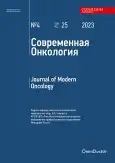Dermatological toxicity in the treatment of malignant tumors in children: A review
- Authors: Belysheva T.S.1, Shatokhina E.A.2,3, Komarova A.D.2
-
Affiliations:
- Blokhin National Medical Research Center of Oncology
- Central State Medical Academy of Department of Presidential Affairs of the Russian Federation
- Medical Research and Educational Center of Lomonosov Moscow State University
- Issue: Vol 25, No 4 (2023)
- Pages: 518-524
- Section: CLINICAL ONCOLOGY
- URL: https://journals.rcsi.science/1815-1434/article/view/252445
- DOI: https://doi.org/10.26442/18151434.2023.4.202513
- ID: 252445
Cite item
Full Text
Abstract
Modern antitumor drugs have high antitumor activity. But only a number of them realize their antitumor effect in a targeted manner with minimal manifestations of concomitant toxicity. Damage to the skin and mucous membranes as part of the toxic effects of chemotherapy not only reduces the quality of life of patients, but can lead to disruption of the patient’s nutritional status, infection, and generalization of the infectious process with the development of sepsis. This review describes the major drugs that have dermatological toxicity, the main clinical variants of dermatological toxicity, methods for their prevention and treatment.
Full Text
##article.viewOnOriginalSite##About the authors
Tatiana S. Belysheva
Blokhin National Medical Research Center of Oncology
Author for correspondence.
Email: klinderma@bk.ru
ORCID iD: 0000-0001-5911-553X
D. Sci. (Med.)
Russian Federation, MoscowEvgeniya A. Shatokhina
Central State Medical Academy of Department of Presidential Affairs of the Russian Federation; Medical Research and Educational Center of Lomonosov Moscow State University
Email: e.a.shatokhina@gmail.com
ORCID iD: 0000-0002-0238-6563
D. Sci. (Med.)
Russian Federation, Moscow; MoscowAnastasia D. Komarova
Central State Medical Academy of Department of Presidential Affairs of the Russian Federation
Email: klinderma@bk.ru
ORCID iD: 0009-0004-9146-6523
Clinical Resident
Russian Federation, MoscowReferences
- Валиев Т. Т. Современная стратегия диагностики и лечения неходжкинских лимфом у детей: автореф. дис. … д-ра мед. наук. М. 2014 [Valiev TT. Sovremennaia strategiia diagnostiki i lecheniia nekhodzhkinskikh limfom u detei: avtoref. dis. … d-ra med. nauk. Moscow. 2014 (in Russian)].
- Беляева Е.С., Сусулева Н. А., Валиев Т. Т. Значение интенсивной химиотерапии для лечения детей с распространенными стадиями лимфомы Ходжкина. РМЖ. Мать и дитя. 2020;3(2):149-53 [Belyaeva ES, Susuleva NA, Valiev TT. The importance of intensive chemotherapy for advanced Hodgkin lymphoma in children. Russian Journal of Woman and Child Health. 2020;3(2):149-53 (in Russian)]. doi: 10.32364/2618-8430-2020-3–2-149-153
- Барях Е.А., Тюрина Н. Г., Воробьев В. И., и др. Двенадцатилетний опыт терапии лимфомы Беркитта по протоколу ЛБ-М-04. Терапевтический архив. 2015;87(7):4-14 [Baryakh EA, Tyurina NG, Vorobyev VI. Therapy for Burkitt’s lymphoma according to the BL-M-04 protocol: 12-year experience. Terapevticheskii Arkhiv (Ter. Arkh.). 2015;87(7):4-14 (in Russian)]. doi: 10.1716/terarkh20158774-14
- Виноградова Ю.Е., Луценко И. Н., Капланская И. Б., и др. Эффективность терапии различных вариантов анаплазированных Т-крупноклеточных лимфом. Терапевтический архив. 2008;80(7):33-7 [Vinogradova IuE, Lutsenko IN, Kaplanskaia IB, et al. Efficacy of therapy of different variants of anaplastic large T-cell lymphomas. Terapevticheskii Arkhiv (Ter. Arkh.). 2008;80(7):33-7 (in Russian)].
- Валиев Т.Т., Шервашидзе М. А., Белышева Т. С. Оценка токсичности терапии острого лимфобластного лейкоза по протоколу ALL IC-BFM 2002. Онкогематология. 2022;17(3):137-59 [Valiev TT, Shervashidze MA, Belysheva TC. Toxicity assessment of acute lymphoblastic leukemia treatment protocol ALL IC-BFM 2002. Oncohematology. 2022;17(3):137-59 (in Russian)]. doi: 10.17650/1818-8346-2022-17-3-137-159
- US Department of Health and Human Services. Common Terminology Criteria for Adverse Events (CTCAE) Version 5. Available at: https://ctep.cancer.gov/protocoldevelopment/electronic_applications/docs/CTCAE_v5_Quick_ Reference_5x7.pdf. Accessed: 22.11.2023.
- Королева И.А., Болотина Л. В., Гладков О. А., и др. Практические рекомендации по лекарственному лечению дерматологических реакций у пациентов, получающих противоопухолевую лекарственную терапию. Злокачественные опухоли: Практические рекомендации RUSSCO. 2021;11:99-113 [Koroleva IA, Bolotina LV, Gladkov OA, et al. Practical recommendations for drug treatment of dermatological reactions in patients receiving anticancer drug therapy. Malignant Tumors: Practical Guidelines RUSSCO. 2021;11:99-113 (in Russian)]. doi: 10.18027/2224-5057-2021-11-3s2-42
- Segaert S, Van Cutsem E. Clinical signs, pathophysiology and management of skin toxicity during therapy with epidermal growth factor receptor inhibitors. Ann Oncol. 2005;16(9):1425-33. doi: 10.1093/annonc/mdi279
- Perez-Soler R, Delord JP, Halpern A, et al. HER1/EGFR inhibitor-associated rash: future directions for management and investigation outcomes from the HER1/EGFR inhibitor rash management forum. Oncologist. 2005;10(5):345-56. doi: 10.1634/theoncologist.10-5-345
- Bernier J, Bonner J, Vermorken JB, et al. Consensus guidelines for the management of radiation dermatitis and coexisting acne-like rash in patients receiving radiotherapy plus EGFR inhibitors for the treatment of squamous cell carcinoma of the head and neck. Ann Oncol. 2008;19(1):142-9. doi: 10.1093/annonc/mdm400
- Шатохина Е.А., Поткин С. Б., Мальков П. Г., и др. Специфика ладонно-подошвенной кожной реакции, индуцированной мультикиназными ингибиторами: клинические, гистологические и ультразвуковые характеристики. Опухоли головы и шеи. 2020;10(2):30-7 [Shatokhina EA, Potkin SB, Malkov PG, et al. Specificity of hand-foot skin reaction induced by multikinase inhibitors: clinical, histological and ultrasound characteristics. Head and Neck Tumors (HNT). 2020;10(2):30-7 (in Russian)]. doi: 10.17650/2222-1468-2020-10-2-30-37
- Сачук О.В., Валиев Т. Т., Кравченко Н. Е., Суетина О. А. Вопросы качества жизни при лимфомах у детей. MD-Onco. 2022:2(1):65-73 [Sachuk OV, Valiev TT, Kravchenko NE, Suetina OA. Aspects of quality of life in pediatric lymphoma patients. MD-Onco. 2022;2(1):65-73 (in Russian)]. doi: 10.17650/2782-3202-2022-2-1-65-73
- Noizet M, Bianchi P, Galliano M, et al. Broad spectrum repairing properties of an extract of Aquaphilus dolomiae on in vitro and ex vivo models of injured skin. J Eur Acad Dermatol Venereol. 2020;34(Suppl. 5):37-42. doi: 10.1111/jdv.16477
- Nguyen T, Chol B, Maitre M, et al. Additional pharmacological activity of I-modulia and generation of two newly designed extracts of Aquaphilus dolomiae culture for dermocosmetic actives. J Eur Acad Dermatol Venereol. 2020;34(Suppl. 5):27-9. doi: 10.1111/jdv.16546
- Miyamoto M. Reducing the incidence and severity of oral mucositis – can it be done? US Oncological Disease. 2007;1(2):18-21.
Supplementary files












